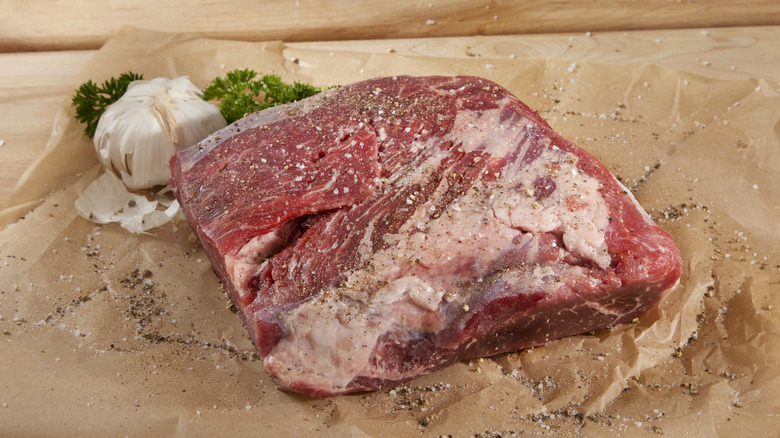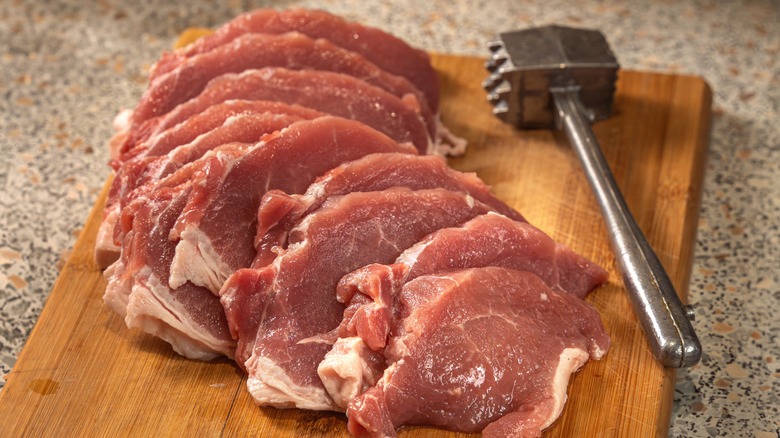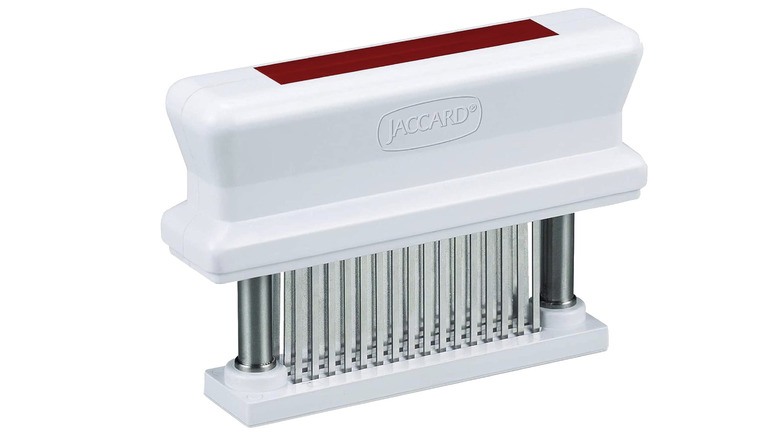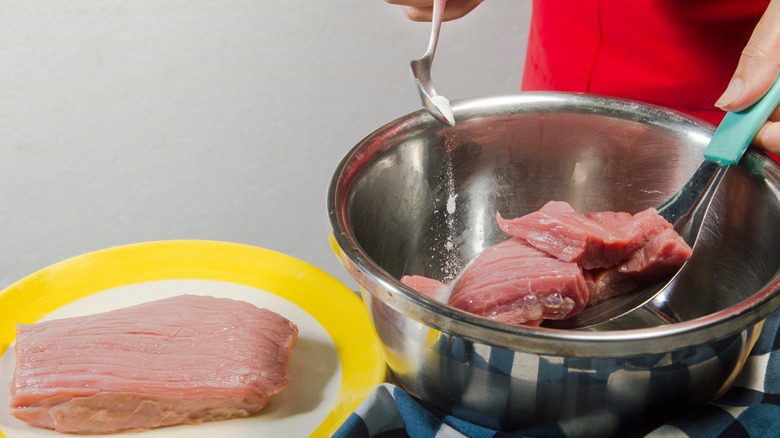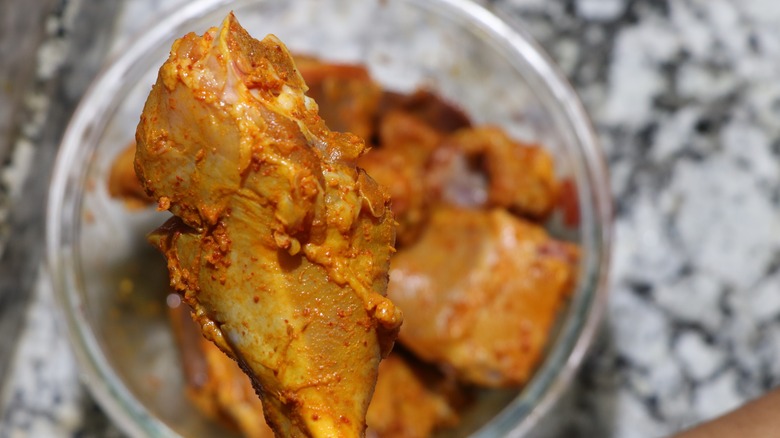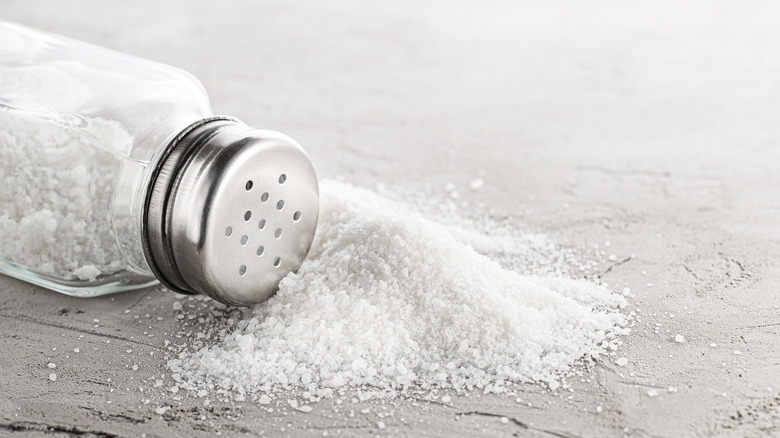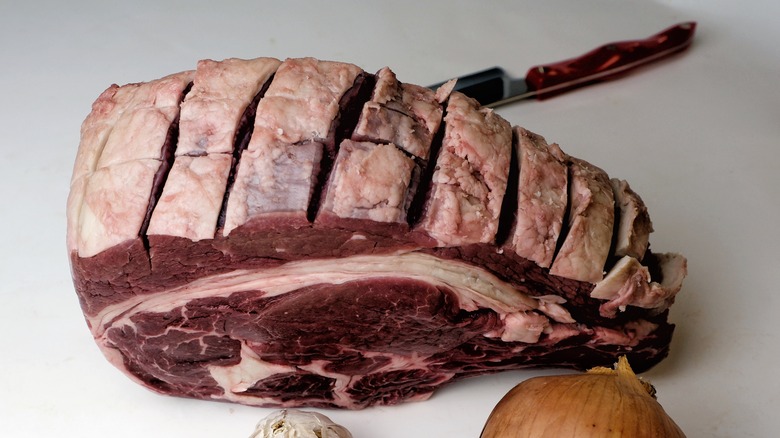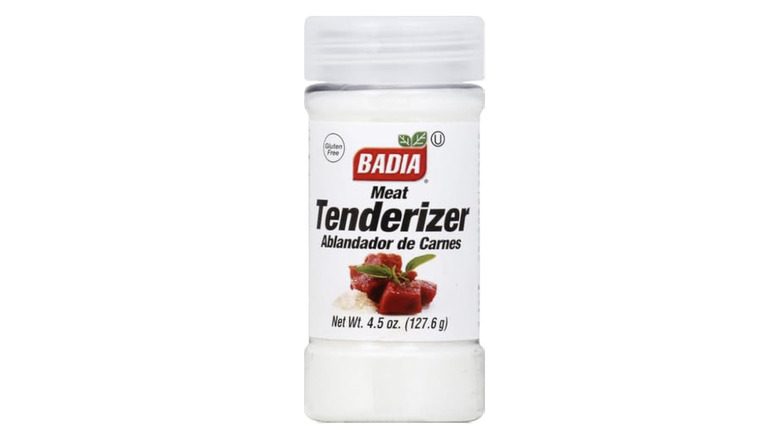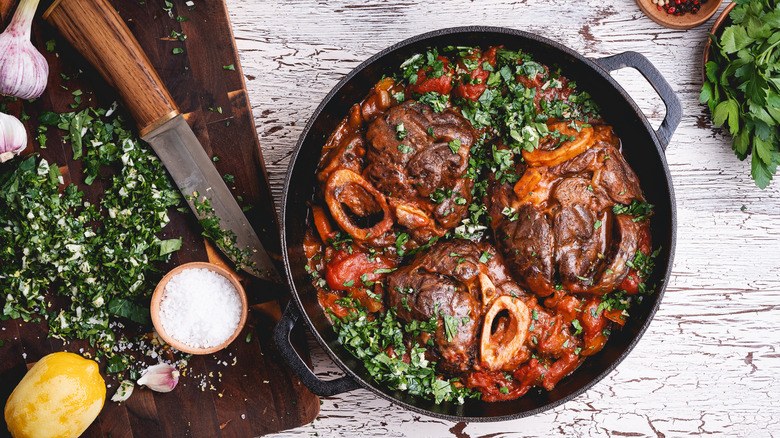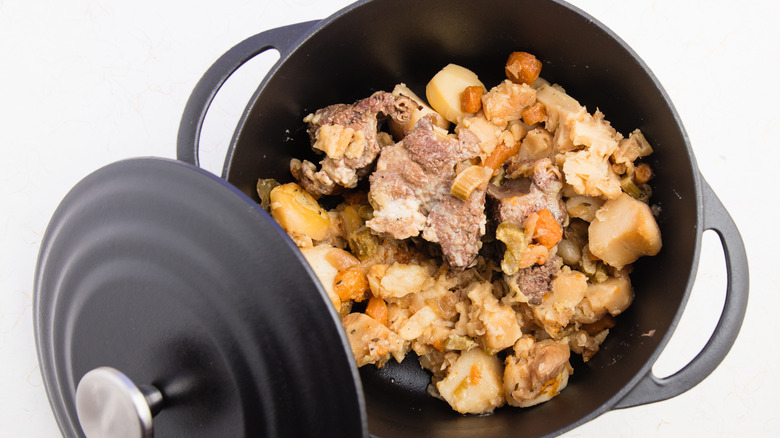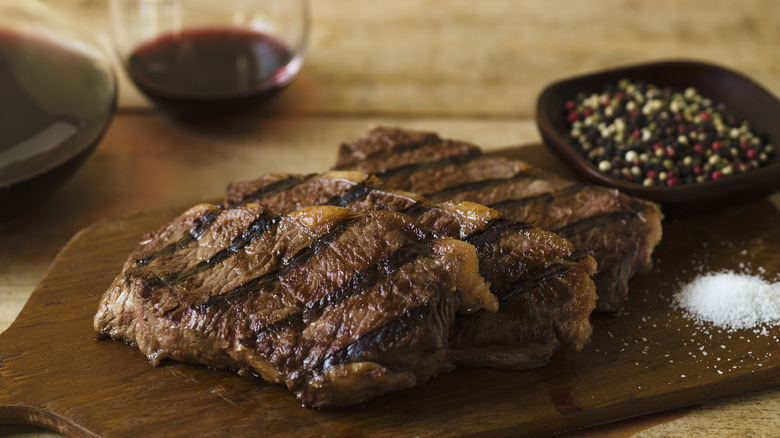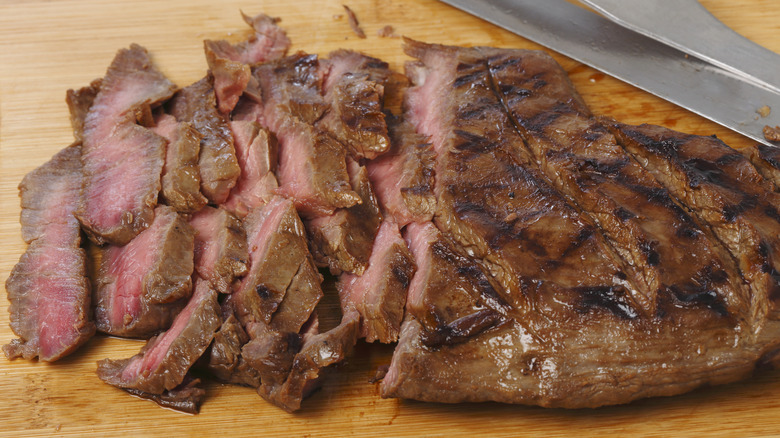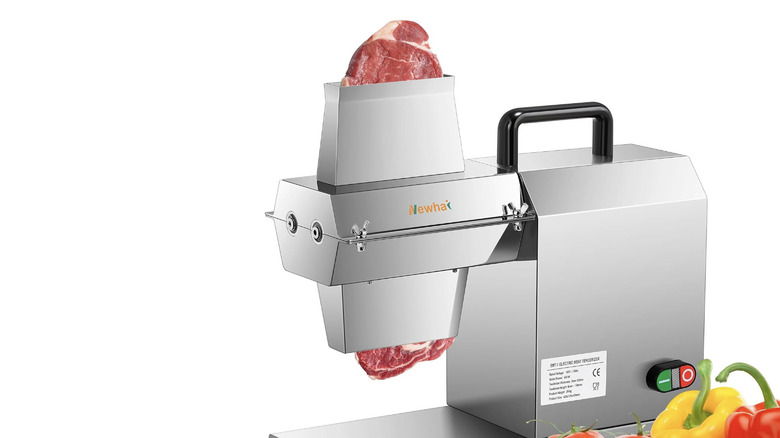13 Ways To Tenderize Tough Meat
We may receive a commission on purchases made from links.
While many premium cuts of meat, such as filet mignon or ribeye, are naturally tender, others can benefit from tenderizing. As a rule of thumb, the texture of a cut of meat depends on its origin, as well as the age and activity level of the animal. Because the neck, chest, shoulders, and front limbs usually get a workout, these tend to be tougher than other parts of the animal. A few of the more challenging cuts of meat to cook include chuck, brisket, flank, bottom round, and tri-tip from beef, as well as lamb and pork legs and shoulders. Similarly, chicken and turkey legs are usually tougher than chicken and turkey breast meat.
Budget-friendly meat tends to have more connective tissue and muscle fibers — this is precisely what makes it tougher but also flavorful if prepared in the right way. This is where different methods of tenderizing the meat can be a game changer. Techniques like braising, marinating, and mechanical tenderizing, which involves physically tearing through the connective tissue, can transform these tougher cuts into succulent treats.
Ready to find out how to get the most out of tough cuts of meat? Take a look at these tried-and-true tenderizing methods.
Pound the meat with a meat mallet
One of the simplest — and most common — ways to tenderize tough meat is by breaking down its muscle fibers. This is often done with a meat mallet, a hammer-like kitchen utensil with two sides: a smooth side designed for flattening chicken filets or veal cutlets and a spiky side for tenderizing meat. In a pinch, you can also achieve a similar effect by whacking the meat with a heavy skillet, a rolling pin, or even a wine bottle. Of course, using anything other than a specialized meat mallet to tenderize meat may require a little more effort and take longer.
To pound the meat, place it on a cutting board or another flat surface. Next, cover it with plastic wrap or wax paper and pound it with the spiky side of the mallet. It's best to begin at the center of the cut and move outward. While beating meat into submission can improve its texture, it's also important not to overdo the job. Excessive pressure can pulverize the meat, turning it mushy and unappetizing.
Poke the meat with a fork or a needle tenderizer
The method of piercing a cut of meat with a fork might just be the fastest way to tenderize a steak. All you need is a fork or another sharp object and a few seconds to puncture holes on both sides of the cut. While the piercing method is similar to tenderizing meat with a meat mallet, as both are mechanical, a fork can penetrate the meat deeper than the coarse surface of a mallet. This doesn't just improve the meat's texture by breaking down its connective tissue, but also opens the meat up, allowing marinades to penetrate deeper into the meat.
Poking holes in a cut of meat with a fork is relatively simple, but you can go one better by investing in a needle tenderizer, such as the Meat Tenderizer with 48 Stainless Steel Ultra Sharp Needle Blades. The handy tool is equipped with dozens of ultra sharp needles that penetrate the meat, creating channels. To use a needle tenderizer, simply place the meat on an even surface, grip the handle, and press firmly down.
Sprinkle the meat with baking soda
It's difficult to imagine that sprinkling a little baking soda on a cut of meat could turn it from tough and leathery to soft and tender. While the effect is likely to be more subtle than this, when applied correctly, baking soda can improve the texture and juiciness of tougher cuts of meat, making them easier to chew and more enjoyable to eat.
The technique of tenderizing meat with baking soda relies on raising the pH levels on the surface of the meat. A higher pH level prevents the proteins in the meat from forming strong bonds while it's being cooked, ensuring a juicier and more tender final result. Since the baking soda won't penetrate deeply into the meat, it's best to use this method on cuts no thicker than ½ inch.
For this method, cover the meat in baking soda, using a quantity equal to 1% of the protein's weight. Place the meat in the refrigerator for at least three hours. For bigger cuts, you may wish to leave it in the refrigerator overnight. Once ready, remove the baking soda by rinsing the meat thoroughly under running water. If time is of the essence, you can also use baking soda to make a wet brine, mixing 1 tablespoon of baking soda with ½ cup of water per 12 ounces of protein. Depending on its size, the meat will need to marinate in the mixture for at least 15 minutes.
Use a marinade
Marinades don't just imbue meat with flavor, they also tenderize it. More specifically, they break down tough connective tissues in cuts of beef and help pork loin or chicken breast stay moist, especially when grilled. Most marinades consist of three key elements: oil, seasoning, and either an acid or an enzyme. All of these ingredients perform different functions. The seasoning infuses the meat with flavor, the oil helps to carry the flavor and keeps the meat moist, while the acid and enzymes tenderize the meat.
Both acids and enzymes tenderize meat by breaking down its proteins, particularly collagen and muscle fibers, which can make meat tough. Some of the acidic ingredients that are often incorporated in marinades include citrus fruit, vinegar, buttermilk, and, perhaps surprisingly to some, yogurt and soda. Similarly, enzymes in fruits like mangoes, kiwis, pineapples, and papaya can also effectively break down the connective tissue in meat.
To tenderize meat without turning it to mush, pay close attention to marinating time. It goes without saying that larger and tougher cuts, such as brisket or pork shoulder, should be marinated for longer than thinner and smaller pieces of meat. For instance, while thicker cuts of meat can be kept in the marinade for up to 12 hours, thinner or more delicate cuts may require as little as 30 minutes.
Sprinkle the meat with a little salt
Salt has been used as a meat preservative for thousands of years. Ancient civilizations used salt to brine meat, which helped prolong its shelf life by drawing out moisture and inhibiting bacteria. While refrigeration has simplified meat storage, salt is still sometimes used on meat as a natural tenderizer. Dry brining, or sprinkling tougher cuts of meat with salt, can break down the proteins in the muscle fibers, giving it a softer texture.
Salt can be used on a range of meats, including beef, pork, and even chicken. In fact, salt brine can also be used to crisp up the skin on chicken. For best results, use around ½ teaspoon of salt per each pound of meat. Coat the cut of meat in the salt, ensuring that it's completely covered. Salt the meat at least an hour before cooking. For larger pieces of protein like whole turkeys or pork butts, you can even salt a day or two in advance — just make sure that you pop them back in the refrigerator after applying the salt. Finally, be sure to rinse the meat under running water and pat it dry before cooking.
Score the meat with a knife
Alongside from pounding meat with a mallet and piercing it with a fork, scoring — or cutting protein with a knife — is another popular method of tenderizing tough cuts like hanger steak or flank. The method is very simple — all you need is a sharp knife. Begin by cutting the meat in one direction before making cuts in the opposite direction until you end up with a crosshatch pattern on the meat's surface. Don't cut too deeply as this could affect the meat's overall structure.
The purpose of scoring is breaking up the long muscle fibers in the meat, resulting in a softer, more tender texture. Scoring also increases the meat's cooking surface, promoting more even cooking and triggering the Maillard reaction, a chemical process that gives meat a beautiful brown crust. Making cuts in the meat can also help it to soak up marinades, if that is a part of its preparation process. Alternatively, you can imbue the meat with flavor by filling the slits with diced aromatics like ginger or garlic or filling them with seasoning.
Use a meat tenderizing powder
While you can tenderize meat by coating it in salt or baking powder, there is another culinary product that can help to soften protein. We are talking about meat tenderizing powder, such as the McCormick Culinary Unseasoned Meat Tenderizer. Available online and in stores, meat tenderizing powder contains enzymes, such as bromelain found in pineapples or papain derived from papayas, that help break down the muscle fibers in the meat, making it more tender and juicy. This said, meat tenderizing powder works best on thinner cuts of meat like steaks or chops as it doesn't penetrate the meat deeper than ¼ inches.
While some meat tenderizing powders are unseasoned, others come with herbs and spices that can enhance the flavor of the meat. The product takes as little as 20 minutes to work, so can be a great option for those on a tight culinary schedule. Meat tenderizing powder is best used as a dry rub, rather than a marinade, as explained by one Reddit user: "If you leave [the] tenderizer on for a long period of time it can turn the meat unpleasantly mushy. So, marinate, then tenderizer."
Infuse the meat with alcohol
It's no secret that adding a splash of liquor, wine, or beer to some culinary creations can enhance their flavor, texture, and aroma. Take vodka cream pasta, for example, where the liquor adds complexity to the tomato sauce, or drunken spaghetti, which is infused with the complex flavor of red wine. With so much culinary versatility, it's no surprise that many home chefs also add a little alcohol to their more meaty dishes.
Marinating meat in alcohol — be it beer, wine, or a spirit — has several benefits. Firstly, it helps to tenderize dishes by weakening tough fibers in the protein, creating a more succulent final product. Alcohol can also imbue meat with flavor, with beers giving protein caramel undertones and wines vibrant floral accents. This said, it's important not to let the boozy flavors overshadow the other components of the marinade. As a rule of thumb, if you don't want to infuse your meat with a distinct boozy flavor, opt for a neutral-tasting spirit like vodka.
Slow cook the meat
Transforming tough cuts of meat like beef brisket, lamb shank, or pork shoulder into tender, mouthwatering meals can take a lot of patience. Fortitude is precisely what you will need if you opt to tenderize these cuts using traditional slow-cooking methods like braising or roasting. On the bright side, cooking protein low and slow breaks down the collagen in the meat, separating the muscle fiber. This, in turn, results in tender and flavorful shreds of meat.
When it comes to slow cooking meat, there are several alternatives. Whether on a stovetop or grill, braising involves simmering meat in a liquid for long periods of time. Since the meat is cooked on low heat with liquid, it remains nice and juicy. If you are barbecuing meat, you can cover it with foil to keep the protein from drying out during the cooking process. Preparing meat on low heat also ensures uniform cooking, eliminating the risk that you will end up with an overcooked outer and a pink center. To brown the meat, pre-sear it or sear it once it's cooked.
Cook the meat in a slow cooker or a pressure cooker
Slow cookers offer a less hands-on way of achieving the same tender, flavorful results as braising or slow-roasting. Whether you are preparing pulled pork or a hearty stew, a slow cooker can both tenderize the meat and lock in moisture. The trick lies in filling the cooker with the right amount of liquid — be it water, stock, or wine. You should also avoid lifting the lid during the cooking process to prevent any moisture from evaporating. If you are cooking a beef stew, for instance, the liquid should fill the slow cooker enough to cover about one-third of the meat. This will ensure that the meat braises, rather than boils.
Pressure cookers can also be used to tenderize meat, albeit in a completely different way from slow cookers. Unlike slow cookers, which rely on low heat over long periods to tenderize meat, pressure cookers use high pressure to rapidly raise the cooking temperature, breaking down collagen into gelatin and softening the meat. Best of all, the meat will be ready in a fraction of the time it would take in a slow cooker.
Let the meat rest after cooking
Once the cut of meat is cooked, it's important to resist the urge to serve it right away. This is because letting the meat rest can go a long way to enhancing its flavor, texture, and juiciness. To get the lowdown on resting times, The Takeout consulted Cordon Bleu-trained chef, Matthew Kreider. "Steaks as a general rule need to rest for at least a third of their cook time. If it's a small steak like a filet I'll usually rest it for a minimum of five minutes," he says. "The larger the steak and longer the cooking time, the longer the steak needs to rest. If you are roasting a prime rib, a 30 to 45 minute rest is not out of the question."
So what's the benefit of resting meat? As meat cooks, the heat draws the juices toward the surface. Letting the protein rest allows the juices to be redistributed evenly into the meat, preventing them from spilling out when the protein is cut open. In addition, leaving meat on the counter for a few minutes lets the muscle fibers reabsorb these juices, making the steak more tender. Finally, a few minutes of resting time ensures that the steak finishes cooking using residual heat.
Slice the meat against the grain
Since it's the tough muscle fibers that make meat chewy, it makes sense that severing them after the meat has been prepared will make the cut more tender. Of course, this only applies if you know what you are doing. Slicing the meat with the grain, or parallel to the fibers, will leave them intact, keeping the meat just as tough as when it was first cooked. To tenderize meat, you should always slice it across the grain to shorten the muscle fibers and make the cut less chewy.
While shortening the muscle fibers by cutting meat against the grain is likely to make it easier to chew, it's not going to change the overall quality of the meat. Perhaps one Reddit user sums this up best, saying, "[This technique] doesn't make an actual change in the meat, it just presents the grain to your chompers differently. Easier to split wood along the grain, same with chewing steak."
Use a meat-tenderizing gadget
Fast and efficient, electric meat tenderizers, such as the Newhai Commercial Meat Tenderizer, are a great alternative for those who are processing large batches of meat or don't have a lot of muscle strength. Fitted out with electric motors, these gadgets can transform tough meat within seconds without any effort on your part. To be more specific, the motor powers a stainless steel blade that rotates rapidly, breaking down the muscle fibers and connective tissues in the meat as it passes through the machine.
Those who don't need to process large quantities of tough meat can opt for a manual meat tenderizer that works on a similar principle to its electric counterpart but requires hand power to operate. Gadgets like the Weston Meat Tenderizer Tool & Heavy Duty Cuber feature crank handles that power a set of blades to tenderize the meat. While manual meat tenderizers may require a little more effort than their electric siblings, they tend to be more compact and budget-friendly.
